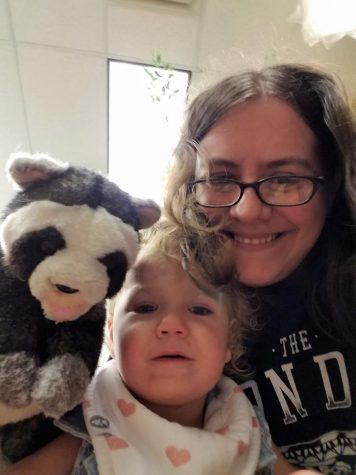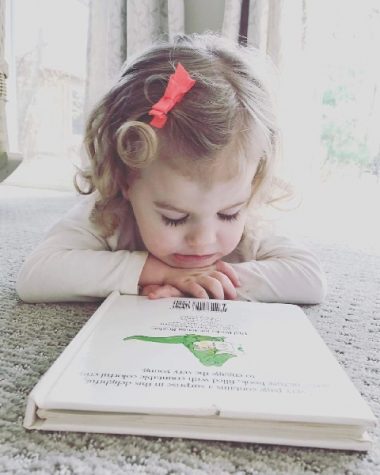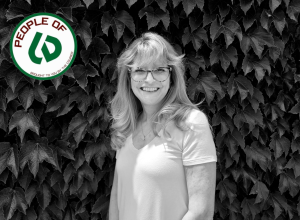“Emma Goes to School” celebrates differences: Adjunct professor begins crowdfunding children’s book
May 15, 2017
It took two years for Emma Nelson to be diagnosed with Schaaf-Yang syndrome, and she became one of the 90 children in the world to be found with it. Adjunct COD professor, Kristin Pack, also the Nelsons’ nanny, and heard the diagnosis along with Emma’s older brother and parents.
Before discovering Emma’s diagnosis, her hands were a very apparent physical difference, but nobody could not discover its reason. Her fingers crossed over one another, and this physical difference immediately created a desire in Pack to find a way to show Emma that her difference did not define her.
This began Pack’s journey with her children’s book, “Emma Goes to School.” The journey began nearly three years ago when Emma was born, but her condition continued to confuse doctors and it would be years before Schaaf-Yang was introduced to the Nelsons and Pack. In that time, Pack had put the book away, but jumped back into the process after Emma’s diagnosis.
“At first, when I wrote it, I was thinking about what Emma’s life would be like if she never got a diagnosis, and if she went to school and everybody asked, ‘Why do your hands look like that?’” said Pack. “The only thing we knew were the physical things. I thought, ‘What would her life be like if she didn’t have a way to describe why, except that’s how she was born?’”
The book was on Pack’s mind far before Schaaf-Yang was on the doctor’s radar. Initially, doctors falsely informed the Nelsons that Emma had a condition where a majority of children did not live to see their first birthday. Pack remembers when the family heard the news while in the natal intensive care unit, and the tense, dark feelings that filled the room.
Physically, Emma’s hands weren’t the only difference. At around one week old, Emma had to undergo surgery that installed a feeding tube into her stomach. The family still uses this to assist Emma with eating and drinking today.
It took over two years of endless tests, scans, MRIs and x-rays on Emma to diagnose her. The whole time, her family had no name to their daughter’s condition. In 2016, Emma was diagnosed with Schaaf-Yang syndrome, and only a few months ago she was diagnosed with Autism Spectrum Disorder.
“Instead of down syndrome, where there’s an extra chromosome, this is a deletion from a very specific part of the chromosome,” explained Pack. “Each kid can have a different number of deletions, which will impact what the disorder will look like for them. There’s only one other kid Dr. Schaaf knows of that has the exact number of deletions as Emma.”
In Pack’s book, the characters are in a fictional monster world where they live in Monstoria and are all around the age of 4. Each character is representative of a different aspect of those with Schaaf-Yang and on the autism spectrum.
“Once she got her diagnosis and [I started] researching that more, I began tailoring it a lot more to Schaaf-Yang. Especially because a lot of the symptoms overlap with a lot of other disorders. It’s not like a lot of people wouldn’t be able to understand, or it wouldn’t appeal.”
The character Emma has a specific claw shape, eluding to Emma’s own hands. There’s Jesse, a character named after Pack’s friend’s son who is on the autism spectrum. He is illustrated with colorful puzzle pieces, representing autism awareness. There’s another character with a lightbulb on their head who only communicated using shadow puppets. This monster is to represent those who can only communicate nonverbally, just like Emma. Each monster eats through straws through their stomachs, exactly like Emma’s feeding tube.
“The characters themselves don’t have special needs,” explained Pack. “They’re just unique in their own way.”
These fictional characters come to life by the hand of 13-year-old Sage Steiner. Pack came across Steiner’s work through a random social media connection. Though only 12 at the time, after Pack received Steiner’s sketches, she found that her work stood out amongst the others. Steiner uses watercolors to turn Pack’s requests into life.
Pack especially loves seeing Steiner’s art grow through the entire process and hopes that the book ends up being a worthwhile experience.
Pack is currently fundraising the self-publishment of “Emma Goes to School” through Kickstarter. After a week of raising, the book has gained 49 backers and over $2,800 out of the $10,000 goal. Soon, Emma will be evaluated and the family will see if she can begin school herself. This has motivated Pack, who hopes to publish the book by the fall when Emma would be attending school for the first time.
When asked what her reaction will be once Emma reaches an age where she’s able to understand her inspiration behind the book, Pack responded, “I’m sure I’ll probably cry like a baby. That’s what the book was for. I can’t wait for that day. Even if I only did this for her.”
“The main focus of this is I want kids to be able to not only understand and accept differences, but to be able to celebrate that fact,” said Pack. “We should all celebrate our differences. I feel like there’s a shame and stigma around a diagnosis. If everybody knew and everyone was aware, or even thought, ‘Oh, she’s different; it doesn’t matter.’”
To learn more, go to EmmaGoestoSchool.com



















